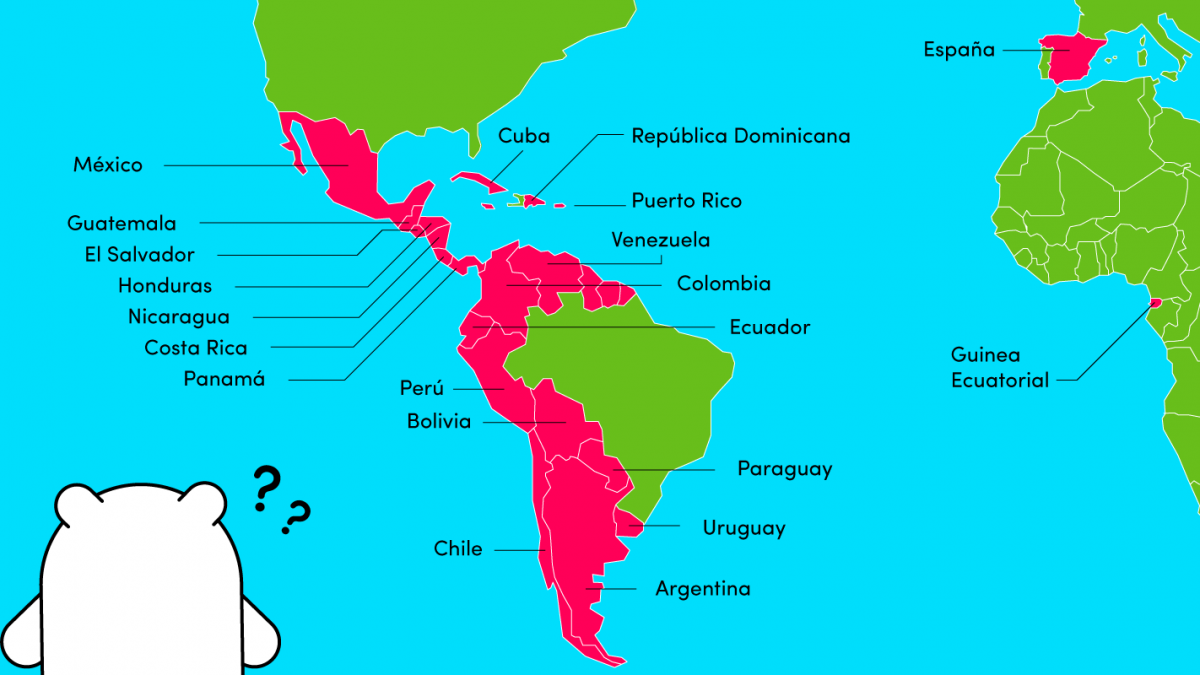Which Spanish Should You Learn?
Great! So you have finally decided to enter the world of the Spanish language. You have so much energy and feel so excited because you can finally order food in Spanish at your favorite Mexican restaurant, talk to your partner’s family or, once and for all, fulfill your dream of moving to Colombia. But then…
“It’s decided! I’m going to start studying Spanish tomorrow!”
“I’m so glad you’re finally taking the plunge. Which Spanish are you going to learn?”
“What do you mean by which?”
“Oh, the Spanish spoken in Latin America is so different from the one in Spain. You need to make a decision before you start. It’s very important!”
People often point out the differences between the Spanish from Latin America and the Spanish from Spain, but rarely emphasize the similarities. This leads many Spanish students to wonder which one they should learn. In this article, I want to show that while the differences matter, there’s no need to worry about them. After all, it’s all the same language!

You’ll be fine with whichever variety you choose to learn and I want to show you why. But first, some data.
Spanish in figures
Did you know that Spanish is the second most spoken language in the world? Surpassed only by Chinese, Spanish has over 470 million native speakers. With this large amount of native speakers, it’s understandable that each country has developed their Spanish a bit differently from other countries throughout history. But that’s not all! Let’s look at some other interesting figures and fun facts:
- Mexico has the largest Spanish speaking population out of any other with 120 million people.
- Over 100 million people speak it as a second language.
- 22 million people study it in 110 countries.
- It’s spoken in 44 countries.
- It was an official language in Western Sahara, Equatorial Guinea and the Philippines.
- It’s the 3rd most widely used language on the Internet.
- It absorbed many Arabic loanwords, around 8% of the modern vocabulary.
- It’s one of the official languages at the United Nations and the European Union.
What are the differences between Latin American Spanish and Spanish from Spain?
The main differences can be found in slang or colloquialisms. Each country has its own, and it can even change within the same country! Remember that these characteristics won’t prevent Spanish speakers from other areas from understanding you. It’s true that there are some differences, but these are just tiny if you compare them to the rest of the language that we have in common. At the end of the day, Spanish is a language with more than 400 million native speakers and we all understand each other. Below you will find a brief summary of the main differences.

Which Spanish is the easiest to learn?
There isn’t one version of Spanish that is easier or harder to learn than another. While the accents and dialects vary from place to place, you can still understand most of what people are saying, regardless of which Spanish you’ve learnt. If you travel to Spain a lot for work, learning Spanish from Spain will be more useful than learning Spain from Argentina. If you plan on traveling to South America, familiarizing yourself with the various accents and slang words would be useful. It’s up to you!
So which is the best Spanish for me to learn?
You may have heard different reasons from different perspectives as to why one variety is better than the other one, and the truth is that they can all be valid. However, you need to keep in mind that the only things that will prevail are your own context and the reason why you’re learning. Let’s look at some possible scenarios:
You have friends or family who speak Spanish as a native language:
If the friends surrounding you speak Spanish from, let’s say, Uruguay, then the best Spanish for you to learn it’s Uruguayan. Logically, that doesn’t mean that you would only be able to speak to people from Uruguay, of course. The beauty of Spanish is that you will be understood by everyone. However, if you are only used to listening to that accent, you might struggle in the beginning when another person talks to you using a different accent.
You want to learn Spanish to pass an exam:
I have really good news for you here! You will pass any official examination regardless of the Spanish variety that you learned. The main body responsible for regulating and issuing official certifications of Spanish, the Instituto Cervantes, accepts and evaluates exams in any of the varieties, as long as the general rules of that variety and/or the general rules are met.
You just want to learn Spanish for fun:
Maybe you’ve recently seen an Almodóvar movie or listened to some of the music from the legendary Chavela Vargas, or perhaps you love to eat arepas! Learning a language requires motivation so why don’t you take advantage of any reason that leads you into the Spanish world and use it at your convenience? In this case, the Spanish variety you want to learn.

Don’t let this choice be an obstacle. Embrace the richness of this wonderful language. Some days it can be hard to navigate the choppy waters of language learning, but you will be surrounded by an immense ocean of gastronomy, history, art, music, cinema, dance and literature and above all, by native speakers who will be delighted to share a little piece of themselves with you.
Want to learn more?
If you’re feeling inspired, sign up below for a free two-week trial and a Live Lesson with a private qualified tutor to start speaking a new language for real! Our classes are structured around exercises created by language teachers, so there’ll be no awkward silences – we promise! 😉
And don’t forget to check out our Facebook, Twitter and Instagram pages for more language content!



